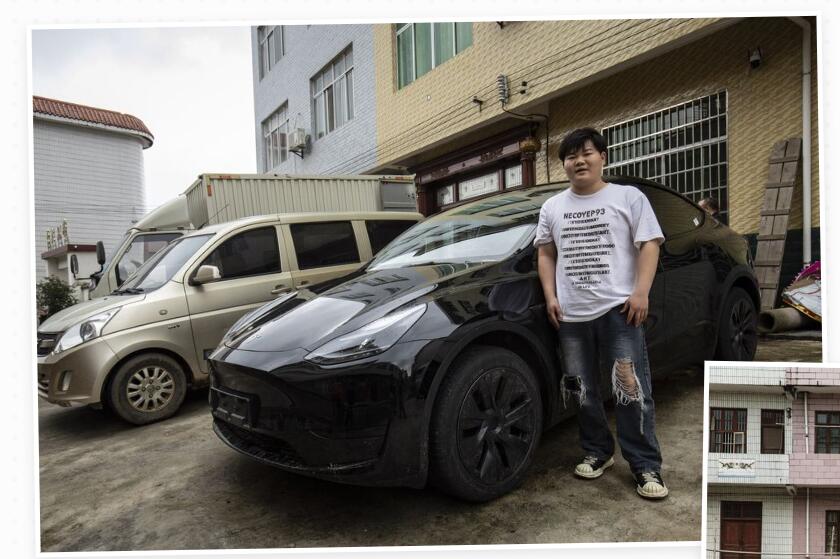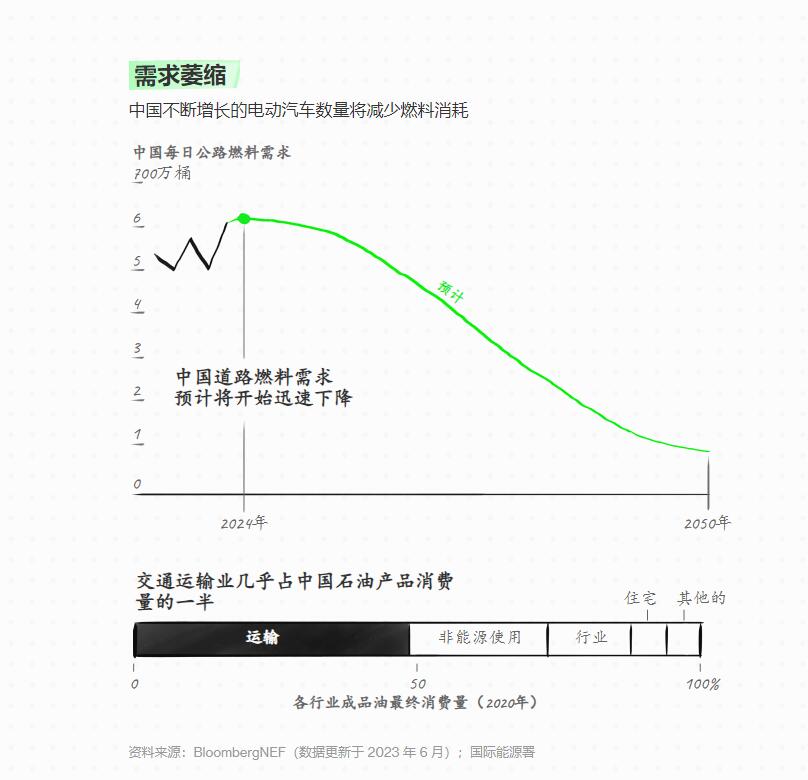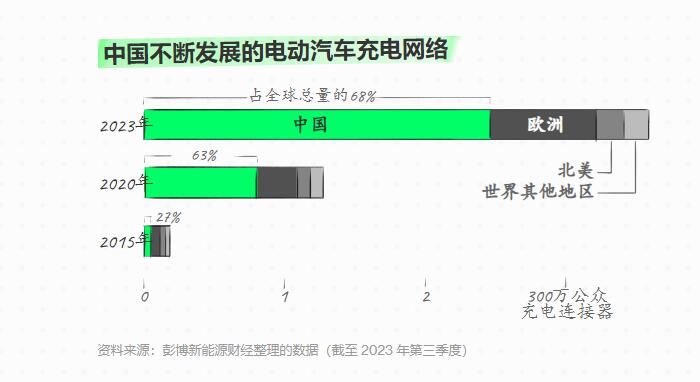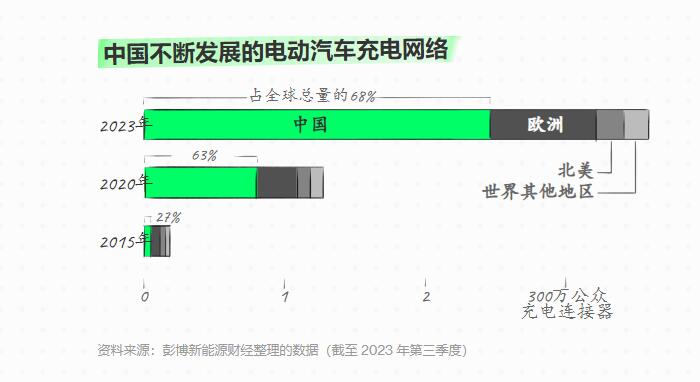 中国的电动汽车产业正在终结石油时代。 一次横跨中国的电动汽车公路旅行揭示了经济和消费者偏好。不仅仅是应对环保问题,也是在加速能源转型。
中国的电动汽车产业正在终结石油时代。 一次横跨中国的电动汽车公路旅行揭示了经济和消费者偏好。不仅仅是应对环保问题,也是在加速能源转型。
Electric Cars Are Driving China Toward the End of the Age of Oil An EV road trip across China reveals how economics and consumer preferences—not green concerns—are hastening the energy transition.
译文简介
中国的电动汽车产业正在终结石油时代。 一次横跨中国的电动汽车公路旅行揭示了经济和消费者偏好。不仅仅是应对环保问题,也是在加速能源转型。
正文翻译
Electric Cars Are Driving China Toward the End of the Age of Oil
An EV road trip across China reveals how economics and consumer preferences—not green concerns—are hastening the energy transition.
中国的电动汽车产业正在终结石油时代。 一次横跨中国的电动汽车公路旅行揭示了经济和消费者偏好。不仅仅是应对环保问题,也是在加速能源转型。
An EV road trip across China reveals how economics and consumer preferences—not green concerns—are hastening the energy transition.
中国的电动汽车产业正在终结石油时代。 一次横跨中国的电动汽车公路旅行揭示了经济和消费者偏好。不仅仅是应对环保问题,也是在加速能源转型。

Taishang, southern China, is more than an hour’s drive from the nearest city. Elderly men still gather at the central wood-frxd clan house to while away the afternoon. Fat chickens roam the village streets.
位于中国南部,距离最近的城市有一个多小时的车程。老人们仍然聚集在中央木结构的宗祠里消磨午后时光。肥鸡在村里的街道上游荡。
Yet parked in front of a house sits a black Tesla Model Y. Sun Hesheng, a 56-year-old businessman who exports plastic hair clips, purchased it recently for his son, Sun Yajun. The elder Sun was pleased by the lower costs of running the electric car compared to its petrol counterparts, while the younger was more focused on its stylish design and high-tech features. “Tesla is the fashion and the future,” said the 20-year-old.
然而,停在一所房子前面的是一辆黑色特斯拉Model Y。56岁的商人孙鹤生最近为他的儿子孙亚军购买了这辆车。孙鹤生对这辆电动车的运行成本比汽油车低这件事感到高兴,而年轻的孙亚军更关注它的时尚设计和高科技功能。“特斯拉是时尚和未来,”这位20岁的年轻人说。
然而,停在一所房子前面的是一辆黑色特斯拉Model Y。56岁的商人孙鹤生最近为他的儿子孙亚军购买了这辆车。孙鹤生对这辆电动车的运行成本比汽油车低这件事感到高兴,而年轻的孙亚军更关注它的时尚设计和高科技功能。“特斯拉是时尚和未来,”这位20岁的年轻人说。
Sun and his car, whom we met on a 2,000-kilometer (1,200 miles), five-day road trip, are part of China’s extraordinary electric vehicle boom. Since the beginning of 2017, China has chalked up more than 18 million EV sales, nearly half the world’s total and over four times more than the US, according to BloombergNEF data. By 2026, the research group projects that over 50% of all new passenger vehicle sales in China will be electric, compared to a little over a quarter in the US.
我们在一次2000公里(1200英里),为期五天的公路旅行中遇到了孙先生和他的车,他们的车是中国卓越的电动汽车产业的一部分。根据彭博新能源财经数据,自2017年初以来,中国的电动汽车销量已经超过1800万辆,几乎占全球总量的一半,是美国的四倍多。研究小组预测,到2026年,中国新乘用车销量的50%以上将是电动汽车,而美国仅仅占四分之一左右。
我们在一次2000公里(1200英里),为期五天的公路旅行中遇到了孙先生和他的车,他们的车是中国卓越的电动汽车产业的一部分。根据彭博新能源财经数据,自2017年初以来,中国的电动汽车销量已经超过1800万辆,几乎占全球总量的一半,是美国的四倍多。研究小组预测,到2026年,中国新乘用车销量的50%以上将是电动汽车,而美国仅仅占四分之一左右。
This surge in domestic purchases has helped Chinese companies build a dominant position in the world’s EV supply chain, creating angst in the US and Europe as policymakers worry about being left behind. But the ramifications of China’s switch from the internal combustion engine has consequences far beyond the auto industry.
这种国内购买激增帮助中国公司在全球电动汽车供应链中建立了主导地位,让美国和欧洲的政策制定者担心自己会被甩在后面。但中国从燃油车转向电动汽车的影响远不止于汽车行业。
这种国内购买激增帮助中国公司在全球电动汽车供应链中建立了主导地位,让美国和欧洲的政策制定者担心自己会被甩在后面。但中国从燃油车转向电动汽车的影响远不止于汽车行业。
“Every car you start driving with electricity, you’re not driving with oil,” said Robert Brecha, a professor of sustainability at the University of Dayton in Ohio. “If it [China’s EV growth rate] keeps up for the next decade, it’s going to put a big dent into oil consumption globally."
俄亥俄州戴顿大学的可持续发展学教授罗伯特·布雷查说:“每使用一辆电驱动的车,都意味着会减少使用石油。”“如果(中国的电动汽车增长速度)在未来十年内持续下去,将对全球石油耗量将大打折扣。”
俄亥俄州戴顿大学的可持续发展学教授罗伯特·布雷查说:“每使用一辆电驱动的车,都意味着会减少使用石油。”“如果(中国的电动汽车增长速度)在未来十年内持续下去,将对全球石油耗量将大打折扣。”
China is the world’s biggest crude importing nation. Its massive two-decade long growth in consumption helped bring prices into the $100s per barrel range and made billionaires out of Texas wildcatters and Middle Eastern emirs.
中国是世界上最大的原油进口国。二十年多年来的消费增长使原油价格飙升到每桶100美元以上,并使得得克萨斯州的野蛮开采者和中东的埃米尔成为亿万富翁。
中国是世界上最大的原油进口国。二十年多年来的消费增长使原油价格飙升到每桶100美元以上,并使得得克萨斯州的野蛮开采者和中东的埃米尔成为亿万富翁。
The transport sector accounts for nearly half of China’s overall oil consumption, so with the growing number of EVs meaning demand for fuel is expected to fall, analysts and industry executives alike are bringing forward predictions for when China will reach its peak oil moment. Zhou xinhuai, the chief executive officer of state-owned oil giant Cnooc Ltd. said in August the widespread industry consensus is now that the all-time high will be reached this year.
交通运输业占中国整体石油消费的近一半,因此随着电动汽车数量的增加,燃料需求预计将下降,分析师和行业高管们都提前预测中国何时将达到石油消耗的峰值。中国国有石油巨头中海油有限公司的首席执行官周新槐在8月份表示,广泛的行业共识是今年将达到历史最高峰。
交通运输业占中国整体石油消费的近一半,因此随着电动汽车数量的增加,燃料需求预计将下降,分析师和行业高管们都提前预测中国何时将达到石油消耗的峰值。中国国有石油巨头中海油有限公司的首席执行官周新槐在8月份表示,广泛的行业共识是今年将达到历史最高峰。

Possible replacement sources of oil demand like India don’t have China’s deep pockets, potentially creating the conditions for a structural slide in prices that could weaken exporters like Russia and Saudi Arabia. There are other geopolitical implications too: China’s historic dependence on energy imports—a major source of concern for its leaders—has played a role in key foreign policy decisions from its aggressive expansion in the South China Sea to its no-limits friendship with Russia to***’s signature Belt and Road Initiative. Its purchases underpin friendships.
有替代石油需求的国家,比如说印度,并没有中国那样雄厚的资金实力,这可能导致石油价格下滑,进而削弱俄罗斯和沙特阿拉伯等出口国的实力。还有其他地缘政治影响:中国对能源进口的路径依赖——这是中国极为关注的主要问题——已经在一些重要的外交决策中发挥了作用,在南海的激进扩张到与俄罗斯的不设限的关系,再到中国的标志性“一带一路”倡议。中国的购买支撑着友谊关系。
“China won’t be the same sort of guaranteed bet for oil demand growth that it’s been in the last 10 years,” said Ciaran Healy, an oil market analyst at the International Energy Agency. “It has big implications for people all over the world.”
“中国不再会像过去10年那样成为石油需求增长的关键,”国际能源署的石油市场分析师西兰-希利说道。“这对世界各地的人们都有重大影响。”
“中国不再会像过去10年那样成为石油需求增长的关键,”国际能源署的石油市场分析师西兰-希利说道。“这对世界各地的人们都有重大影响。”
Still, predictions of peak oil demand in general—and in China especially—have a long history of being premature. Its largest state-owned oil company, China National Petroleum Corp., in 2017 forecast that consumption would eventually top out at 690 million tons a year. The next year, it upped that to 700 million tons, then to 740 million before landing on 780 million tons, its current outlook.
不过,对石油需求达到峰值的预测——尤其是在中国——一直以来都为时过早。中国最大的国有石油公司——中国石油天然气集团公司——在2017年预测石油消费最终将达到每年6.9亿吨。次年,他们将这一数字上调至7亿吨,然后又调至7.4亿吨,最终确定为7.8亿吨,这是他们目前的预测。
原创翻译:龙腾网 https://www.ltaaa.cn 转载请注明出处
不过,对石油需求达到峰值的预测——尤其是在中国——一直以来都为时过早。中国最大的国有石油公司——中国石油天然气集团公司——在2017年预测石油消费最终将达到每年6.9亿吨。次年,他们将这一数字上调至7亿吨,然后又调至7.4亿吨,最终确定为7.8亿吨,这是他们目前的预测。
原创翻译:龙腾网 https://www.ltaaa.cn 转载请注明出处
Power lines dot the highway between Shanghai and Suzhou.
And calling the peak relies on the assumption that China’s EV adoption rates will keep surging. That isn’t a given. For EVs to truly become universal they can’t just be cars of the city; they need to be able to operate in the country’s vast hinterlands. And they can’t just appeal to early adopters; they need to become the option of choice for people up and down the social scale. In China, where consumer preference surveys of the depth common in the West are practically unknown, and getting any sort of reliable data is increasingly hard, whether this is happening isn’t something that can be determined from behind a desk.
上海和苏州之间的高速公路上布满了充电桩。
判断达到峰值的前提是中国的电动汽车采用率继续激增。这并非是一定会发生的事情。要让电动汽车真正普及,它们不能只是城市中的交通工具;它们需要能够在中国广袤的腹地来往奔跑。而且它们不能只吸引早期使用者;需要成为社会各阶层人们的首选。在中国,西方常见的消费者偏好调查几乎是没有的,而且越来越难获取任何可靠的数据,这不是能在办公桌上就能确定的。
And calling the peak relies on the assumption that China’s EV adoption rates will keep surging. That isn’t a given. For EVs to truly become universal they can’t just be cars of the city; they need to be able to operate in the country’s vast hinterlands. And they can’t just appeal to early adopters; they need to become the option of choice for people up and down the social scale. In China, where consumer preference surveys of the depth common in the West are practically unknown, and getting any sort of reliable data is increasingly hard, whether this is happening isn’t something that can be determined from behind a desk.
上海和苏州之间的高速公路上布满了充电桩。
判断达到峰值的前提是中国的电动汽车采用率继续激增。这并非是一定会发生的事情。要让电动汽车真正普及,它们不能只是城市中的交通工具;它们需要能够在中国广袤的腹地来往奔跑。而且它们不能只吸引早期使用者;需要成为社会各阶层人们的首选。在中国,西方常见的消费者偏好调查几乎是没有的,而且越来越难获取任何可靠的数据,这不是能在办公桌上就能确定的。
So to see whether the EV infrastructure on the ground—and people’s attitudes—tally with the bold switchover projections, Bloomberg News decided to take an EV road trip. Travelling from the glitzy eastern coastal megacity of Shanghai, via the industrial powerhouse of Wuhan, and then into the country’s remote mountainous center, we wanted to see if we could get a glimpse of the end of the oil age.
因此,为了了解电动汽车基础设施以及人们的态度是否与大胆的转型预测相符,彭博新闻社决定进行一次电动汽车之旅。我们从东部沿海繁华的大都市上海出发,经过工业重镇武汉,然后进入中国偏远的山区地带,我们想看看是否能一窥石油时代的终结。
因此,为了了解电动汽车基础设施以及人们的态度是否与大胆的转型预测相符,彭博新闻社决定进行一次电动汽车之旅。我们从东部沿海繁华的大都市上海出发,经过工业重镇武汉,然后进入中国偏远的山区地带,我们想看看是否能一窥石油时代的终结。

EVs in China come in many shapes and sizes, from the ultra-luxury Yangwang SUV, which can get 1,000 kilometers on a single charge, to the basic Wuling Hongguang Mini, which can get about 120 kilometers. We chose something in-between: a BYD Qin, the first new energy A-class sedan to eclipse one million sales, according to the manufacturer.
中国的电动汽车有各种各样的款式和尺寸,从可以单次充电行驶1000公里的超豪华仰望SUV,到可以行驶约120公里的小号的五菱宏光。我们选择了介于两者之间的车型:比亚迪-秦,这是第一款新能源A级轿车,根据制造商的说法已经突破了一百万的销量。
The petrol station where we picked up the car in Shanghai was an early indicator that even legacy fossil fuel companies are betting the transition to electric cars has legs. Operated by Sinopec, China’s largest oil refiner, there were not only gasoline and diesel pumps, but about 20 lime-green charging posts and a shipping container-sized battery swapping station.
我们在上海取车的加油站,看到即使是传统的化石燃料公司也在押注向电动汽车的过渡。这家加油站由中国最大的石油炼制企业中石化运营,不仅有汽油和柴油,还有大约20个青绿色的充电桩和一个集装箱大小的电池交换站。
我们在上海取车的加油站,看到即使是传统的化石燃料公司也在押注向电动汽车的过渡。这家加油站由中国最大的石油炼制企业中石化运营,不仅有汽油和柴油,还有大约20个青绿色的充电桩和一个集装箱大小的电池交换站。
The station attendant, who only gave his surname, Zhang, said in the few years since the station opened, charging has grown from an experiment—this was the state-owned firm’s first multi-purpose refueling stop in Shanghai—to its main offering. Cars charge 24 hours a day and at lunchtime it was so full of drivers smoking while waiting to fill their batteries that Sinopec had to install a concrete wall between the two areas so stray cigarettes didn’t become a safety hazard around the fuel pumps.
这位加油站的服务员,只告诉我们他姓张,说自从这个加油站开业几年来,充电业务已经从一项实验发展成为主要服务项目。汽车可以24小时充电,中午的时候,充电区域挤满了等待充电的司机,他们一边吸烟一边等待充电,以至于中石化不得不在两个区域之间安装了一堵混凝土墙,以免烟头在加油泵周围成为安全隐患。
这位加油站的服务员,只告诉我们他姓张,说自从这个加油站开业几年来,充电业务已经从一项实验发展成为主要服务项目。汽车可以24小时充电,中午的时候,充电区域挤满了等待充电的司机,他们一边吸烟一边等待充电,以至于中石化不得不在两个区域之间安装了一堵混凝土墙,以免烟头在加油泵周围成为安全隐患。
“No one will drive a gasoline car in the future,” Zhang said. “It’ll be a world for electric cars.”
张先生说:“将来没有人会开汽油车,电动汽车将会成为主流。”
张先生说:“将来没有人会开汽油车,电动汽车将会成为主流。”
There are other signs too that the oil industry is preparing for a different future. Just 20 minutes’ drive or so from central Shanghai, Sinopec’s Gaoqiao oil refinery sits on the banks of the Huangpu River. It is an example of how things used to be: Built in the 1980s, it was designed to maximize the production of gasoline and diesel. Gleaming pipes and stills that convert raw crude oil into transport fuel and plastics tower above trees meant to provide a buffer between the plant and the world outside.
石油行业正准备迎接不同的未来,还有其他迹象。距离上海市中心约20分钟车程,中国石化的高桥炼油厂坐落在黄浦江畔。它是过去一切的典范:建于上世纪80年代,旨在最大限度地生产汽油和柴油。闪闪发光的管道和蒸馏塔将原油转化为交通燃料和塑料。
石油行业正准备迎接不同的未来,还有其他迹象。距离上海市中心约20分钟车程,中国石化的高桥炼油厂坐落在黄浦江畔。它是过去一切的典范:建于上世纪80年代,旨在最大限度地生产汽油和柴油。闪闪发光的管道和蒸馏塔将原油转化为交通燃料和塑料。
Business is still brisk: From a seafood restaurant across from its main gate, you can watch the near non-stop comings and goings of tanker trucks filling up with petrol and diesel to carry to nearby refueling stations. In a street packed with cars only one, a silver BMW, had the signature green license plate of an electric vehicle.
生意依然兴隆:在正门对面的一家海鲜餐馆里,你可以看到不断进出的油罐车,装载着汽油和柴油,运往附近的加油站。在一条车辆拥挤的街道上,只有一辆银色宝马车上有电动车的标志性绿色车牌。
生意依然兴隆:在正门对面的一家海鲜餐馆里,你可以看到不断进出的油罐车,装载着汽油和柴油,运往附近的加油站。在一条车辆拥挤的街道上,只有一辆银色宝马车上有电动车的标志性绿色车牌。
Newer refiners, like the privately run Zhejiang Petrochemical Co., typically build facilities instead at isolated islands or peninsulas, far from urban areas where the government wants to cut pollution. These are focused on how to maximize the production of petrochemicals for the plastics and chemicals industry. The demand for these sorts of materials is one of the wild cards in peak oil predictions: As China gets richer it’s likely to consume more goods—often made from plastics. Plus jet fuel demand is expected to rise as more Chinese take to the skies.
像浙江石化这样的新型炼油企业通常在偏远的岛屿或半岛建设设施,远离城市地区希望减少污染。这些设施专注于如何最大限度地生产塑料和化工产品。这类材料的需求是石油峰值预测中的变数之一:随着中国变得更富裕,很可能消费更多商品——通常是塑料制品。此外,随着更多中国人乘坐飞机,喷气机燃油的需求预计也会上升。
像浙江石化这样的新型炼油企业通常在偏远的岛屿或半岛建设设施,远离城市地区希望减少污染。这些设施专注于如何最大限度地生产塑料和化工产品。这类材料的需求是石油峰值预测中的变数之一:随着中国变得更富裕,很可能消费更多商品——通常是塑料制品。此外,随着更多中国人乘坐飞机,喷气机燃油的需求预计也会上升。
Spend much time driving in China, and you’ll quickly see that the charging facilities such as those at the Sinopec station are no longer an outlier. Unlike many places, such as the US, there is no worry about not being able to find a spot: China has about 2.5 million public charging stations, far and away the most in the world.
在中国驾驶时间较长,你会很快发现,像中国石化加油站那样的充电设施不再是个例外。与许多地方不同,例如美国,不用担心找不到停车位:中国拥有大约250万个公共充电站,远远超过全球其他地方。
在中国驾驶时间较长,你会很快发现,像中国石化加油站那样的充电设施不再是个例外。与许多地方不同,例如美国,不用担心找不到停车位:中国拥有大约250万个公共充电站,远远超过全球其他地方。
The growth of the network was both a result of state planning and private enterprise. Giant state-owned companies like State Grid Corp. of China were given mandates to roll out chargers, while private companies like Qingdao TGOOD Electric Co. jumped at the chance to build charging posts—in part to lay early claim to the best locations. Baidu’s mapping software—the Chinese equivalent of Google Maps—has them all integrated, delivering constant reminders of where to go. Payment is typically via an app or the ubiquitous WeChat platform.
这种电力网络的增长既是国家规划的结果,也是私营企业的努力。中国国家电网等大型国有企业被授权推出充电桩,而青岛特锐德电气公司等私营企业则迅速抓住机会建设充电桩,部分是为了早期占据最佳位置。百度的地图软件——中国版的谷歌地图——将它们整合在一起,不断提醒你去哪里。付款通常通过应用程序或无处不在的微信平台进行。
原创翻译:龙腾网 https://www.ltaaa.cn 转载请注明出处
这种电力网络的增长既是国家规划的结果,也是私营企业的努力。中国国家电网等大型国有企业被授权推出充电桩,而青岛特锐德电气公司等私营企业则迅速抓住机会建设充电桩,部分是为了早期占据最佳位置。百度的地图软件——中国版的谷歌地图——将它们整合在一起,不断提醒你去哪里。付款通常通过应用程序或无处不在的微信平台进行。
原创翻译:龙腾网 https://www.ltaaa.cn 转载请注明出处

It was infrastructure we became very, even too, familiar with as we drove. Chargers are getting faster, but currently EV road trips are full of long pit stops. The Qin’s battery would last for a little more than 300 kilometers. Fine for city driving, but problematic on longer journeys. And while filling up a car with gasoline takes a minute or two, it routinely took us about 50 minutes to recharge. (High-end vehicles like Teslas charge faster.) These stops all add up. When we left Shanghai, our ETA in Wuhan was 9.30 p.m. Instead we arrived at 2.30 a.m.
在驾驶过程中,我们对这些基础设施非常熟悉。充电器的充电速度越来越快,但目前的电动车公路旅行充电时间很长。秦的电池续航里程略微超过300公里。对于城市驾驶来说还好,但在长途旅行中会有问题。而加油只需要一两分钟,但充电通常需要约50分钟。(像特斯拉这样的高端车辆充电速度更快。)所有这些停车时间都会累加。当我们离开上海时,我们在武汉的预计到达时间是晚上9:30,但实际上我们到达的时间是凌晨2:30。
Whether the issues caused by such short ranges are enough to dissuade EV adoption may depend on driving customs. Road trips and the pull of the open road are concepts deeply ingrained in American culture, whereas in China, highways are a more recent phenomenon and most cross-country travel is done by high-speed rail.
这种短续航里程带来的问题是否是在阻止电动汽车的普及,可能取决于驾驶习惯。开阔公路旅行是深深植根于美国文化中的概念,而在中国,高速公路是一个相对较新的现象,大多数穿州过省的旅行都是通过高铁完成的。
这种短续航里程带来的问题是否是在阻止电动汽车的普及,可能取决于驾驶习惯。开阔公路旅行是深深植根于美国文化中的概念,而在中国,高速公路是一个相对较新的现象,大多数穿州过省的旅行都是通过高铁完成的。
For those who do routinely drive longer distances, right now the lure is that what you lose in time you can make up for in money. Li Yong, who uses a Changan Auto electric MPV to ship meat from his goose farm in Anhui province to customers several hundred kilometers away, says the switch away from gasoline is saving him about 80% on fuel costs. As the upfront price tag of EVs has come down, cheap power means lifetime ownership of an EV is now less expensive than of a fueled vehicle.
对于那些经常驾驶长距离的人来说,现在的诱惑是,你所损失的时间可以通过省下的钱来弥补。在安徽省的一个养鹅场,李勇使用长安电动多功能车辆将肉类运往几百公里之外的客户,他说电力汽车可以节省大约80%的燃料成本。随着电动汽车的前期价格下降,廉价动力意味着终身拥有电动汽车比拥有燃油车更实惠。
对于那些经常驾驶长距离的人来说,现在的诱惑是,你所损失的时间可以通过省下的钱来弥补。在安徽省的一个养鹅场,李勇使用长安电动多功能车辆将肉类运往几百公里之外的客户,他说电力汽车可以节省大约80%的燃料成本。随着电动汽车的前期价格下降,廉价动力意味着终身拥有电动汽车比拥有燃油车更实惠。
“I won’t go back now,” Li said at a charging station north of Hefei. “Electric cars are so convenient and cost saving.”
“我现在不会回去了,”李在合肥北部的一个充电站说。“电动汽车非常方便和省钱。”
“我现在不会回去了,”李在合肥北部的一个充电站说。“电动汽车非常方便和省钱。”
China has some of the cheapest electricity in the world thanks both to massive adoption of renewables and a bounty of low-cost coal, the world’s dirtiest fossil fuel. China consumes more than half the world’s supply, and coal accounts for about 60% of its power generation. So while the country is investing heavily in renewables, it’s not like the EV surge has suddenly turned China into an environmentalist’s nirvana—even if it does mean a vital step has been taken.
中国拥有世界上最廉价的电力,这要归功于可再生能源的大规模采用以及丰富的低成本煤炭资源,这是世界上最脏的化石燃料。中国消耗了全球一半以上的煤炭,并且煤炭占其发电量的约60%。因此,尽管该国在可再生能源上投资巨大,但这并不意味着电动汽车的激增突然间将中国变成了环保主义者的天堂——尽管中国确实迈出了至关重要的一步。
中国拥有世界上最廉价的电力,这要归功于可再生能源的大规模采用以及丰富的低成本煤炭资源,这是世界上最脏的化石燃料。中国消耗了全球一半以上的煤炭,并且煤炭占其发电量的约60%。因此,尽管该国在可再生能源上投资巨大,但这并不意味着电动汽车的激增突然间将中国变成了环保主义者的天堂——尽管中国确实迈出了至关重要的一步。
The auto heartland of China is the central city of Wuhan, sometimes referred to as China’s Detroit. It’s the base for Dongfeng Motor Group Co., one of the nation’s largest car companies which partners with the likes of Nissan and Honda to build foreign brands for the domestic market, as well as car-components suppliers such as Aptiv Plc.
中国汽车的中心地带是中部城市武汉,有时被称为中国的底特律。这里是东风汽车集团有限公司的总部,该公司是中国最大的汽车公司之一,与日产和本田等公司合作为国内市场生产外国品牌汽车,以及与德尔福汽车公司这样的汽车零部件供应商合作。
中国汽车的中心地带是中部城市武汉,有时被称为中国的底特律。这里是东风汽车集团有限公司的总部,该公司是中国最大的汽车公司之一,与日产和本田等公司合作为国内市场生产外国品牌汽车,以及与德尔福汽车公司这样的汽车零部件供应商合作。
On the south side of town is Wuhan Car Valley, home to about a dozen different manufacturers and a massive collection of used car dealerships. Salespeople here say that for well-heeled buyers, elite European car brands that still mostly make gasoline cars remain a big draw. Indeed BMW, Mercedes Benz and Audi are often approvingly referred to collectively in China as “BBA.”
在城市的南部是武汉汽车谷,这里有大约十几家不同的制造商和大量的二手车经销商。销售人员表示,对于富裕的购车者来说,欧洲高端汽油车还是一个很大的吸引点。事实上,宝马、奔驰和奥迪在中国通常被称为“BBA”,并且备受赞赏。
在城市的南部是武汉汽车谷,这里有大约十几家不同的制造商和大量的二手车经销商。销售人员表示,对于富裕的购车者来说,欧洲高端汽油车还是一个很大的吸引点。事实上,宝马、奔驰和奥迪在中国通常被称为“BBA”,并且备受赞赏。
Unlike in the US and Europe, climate concerns are typically nowhere on Chinese buyers’ radar, says Li Long, who founded one of the province’s first used EV dealerships, Electric Rabbit, in 2021. There’s no equivalent to Sierra Club types or famous early adopters like actor and environmental activist Leonardo DiCaprio, who helped popularize hybrids in the 2000s and is now frequently photographed in luxury electric models.
与美国和欧洲不同,气候问题通常不在中国购车者的考虑范围之内,省内首家二手电动汽车经销商“电动兔”创始人李龙表示。在这里,没有像美国的“塞拉俱乐部”那样的组织,也没有像演员和环保活动家莱昂纳多·迪卡普里奥那样的著名早期试用者,后者曾在2000年代帮助推广混合动力车型,现在经常被拍摄乘坐豪华电动车。
与美国和欧洲不同,气候问题通常不在中国购车者的考虑范围之内,省内首家二手电动汽车经销商“电动兔”创始人李龙表示。在这里,没有像美国的“塞拉俱乐部”那样的组织,也没有像演员和环保活动家莱昂纳多·迪卡普里奥那样的著名早期试用者,后者曾在2000年代帮助推广混合动力车型,现在经常被拍摄乘坐豪华电动车。
Instead, said Li, who has a showroom floor full of Teslas and other high-end brands, clients are more interested in the bling: screens that can play movies and social media videos, autonomous driving and parking assistance and even built-in karaoke studios. That’s why the domestic industry is doubling down on style and fancy gadgets. At the Shanghai auto show in April, crowds swarmed around futuristic electric roadsters with hologram wheels and SUVs with high-resolution displays stretched across the entire dashboard.
相反,他的展厅里摆满了特斯拉和其他高端品牌的汽车,客户更感兴趣的是车内的装饰:可以播放电影和社交媒体视频的屏幕、自动驾驶和泊车辅助,甚至内置的卡拉OK。这就是为什么国内汽车行业更加注重风格和花哨的小工具。在四月的上海车展上,人群围绕着未来主义电动跑车和整个仪表板上都是高分辨率显示屏的SUV车型。
原创翻译:龙腾网 https://www.ltaaa.cn 转载请注明出处
相反,他的展厅里摆满了特斯拉和其他高端品牌的汽车,客户更感兴趣的是车内的装饰:可以播放电影和社交媒体视频的屏幕、自动驾驶和泊车辅助,甚至内置的卡拉OK。这就是为什么国内汽车行业更加注重风格和花哨的小工具。在四月的上海车展上,人群围绕着未来主义电动跑车和整个仪表板上都是高分辨率显示屏的SUV车型。
原创翻译:龙腾网 https://www.ltaaa.cn 转载请注明出处

Indeed, in China there is sometimes even cynicism about whether there are really any benefits to the planet from driving electric. At a roadside rest stop between Shanghai and Nanjing, alongside the normal restaurants and toilets, sit a pair of showrooms for EVs. About 10 different Chinese brands jostled for prominence. A pair of older men looking around said they were dubious about the environmental claims. Doesn’t manufacturing the battery create just as much pollution as burning petrol, they asked.
事实上,在中国,甚至有人对驾驶电动车是否真的对地球有好处表示怀疑。在上海和南京之间的一家路边休息站,除了普通的餐馆和厕所外,还有两家电动汽车展厅。大约有10个不同的中国品牌争相展示。两个老年男性表示怀疑环保主张。他们询问,制造电池是否会产生与燃烧汽油一样多的污染。
Manufacturing of EVs is more emissions intensive than a combustion engine car, because their heavy batteries require more metals, which are energy- and carbon-intensive to mine and refine. But every time an EV is driven without burning oil, it makes up for a fraction of that difference. Over the course of a typical 17-year life, a Tesla in the US emits 55 tons less carbon dioxide than its gasoline equivalent, according to the company.
电动汽车的制造比燃油发动机汽车更加排放密集,因为它们沉重的电池需要更多金属,而开采和精炼这些金属需要耗费大量能源和碳排放。但每当电动汽车行驶时,不用燃烧油,就弥补了部分差异。根据特斯拉公司的数据,在美国,一辆特斯拉电动汽车的使用寿命为17年,其二氧化碳排放比同等汽油车少55吨。
电动汽车的制造比燃油发动机汽车更加排放密集,因为它们沉重的电池需要更多金属,而开采和精炼这些金属需要耗费大量能源和碳排放。但每当电动汽车行驶时,不用燃烧油,就弥补了部分差异。根据特斯拉公司的数据,在美国,一辆特斯拉电动汽车的使用寿命为17年,其二氧化碳排放比同等汽油车少55吨。
Still, the mining of metals like lithium, nickel and cobalt scars the earth and the rush for such commodities can have grave and even deadly consequences for local communities. In 2019, 43 people who were illegally mining at one of the world’s biggest cobalt reserves in the Democratic Republic of Congo died when part of the mine collapsed.
尽管像锂、镍和钴这样的金属开采对地球造成伤害,对这些商品的争夺可能对当地社区造成严重甚至致命的后果。2019年,在刚果民主共和国世界最大的钴矿之一,有43名非法采矿者在矿井坍塌时丧生。
尽管像锂、镍和钴这样的金属开采对地球造成伤害,对这些商品的争夺可能对当地社区造成严重甚至致命的后果。2019年,在刚果民主共和国世界最大的钴矿之一,有43名非法采矿者在矿井坍塌时丧生。
If electrified transport is going to be truly sustainable, batteries can’t be built from scratch every time. And demand for new lithium-ion batteries is expected to increase about five-fold between 2023 and 2033, according to Julia Harty, an energy transition analyst at FastMarkets. Meeting that will require recycling as well as mining.
如果电动交通要真正可持续,电池就不能每次都从矿石开始制造。根据FastMarkets的能源转型分析师朱莉娅·哈蒂的预测,2023年至2033年间,对新的锂离子电池的需求预计将增加约五倍。要满足这一需求,除了开采,还需要回收利用。
如果电动交通要真正可持续,电池就不能每次都从矿石开始制造。根据FastMarkets的能源转型分析师朱莉娅·哈蒂的预测,2023年至2033年间,对新的锂离子电池的需求预计将增加约五倍。要满足这一需求,除了开采,还需要回收利用。
In Jingmen, about three hours drive west of Wuhan, on a sprawling expanse with a lake, dormitories and pack of company puppies, GEM Co. is doing just that. The company is one of the world’s largest battery recyclers and works with everyone from major manufacturers to tiny traders to source used batteries, which are shipped to logistics centers where they are sorted and stored. Some batteries are still powerful enough to be repackaged and sold, while others need to be chemically recycled.
在武汉以西约三小时车程的荆门,格林美公司就在做这件事。该公司是世界上最大的电池回收商之一,与从大型制造商到小贩都有合作,收集二手电池,然后将其运送到物流中心进行分类和储存。一些电池仍然足够强大,可以重新包装并出售,而另一些需要进行化学回收。
原创翻译:龙腾网 https://www.ltaaa.cn 转载请注明出处
在武汉以西约三小时车程的荆门,格林美公司就在做这件事。该公司是世界上最大的电池回收商之一,与从大型制造商到小贩都有合作,收集二手电池,然后将其运送到物流中心进行分类和储存。一些电池仍然足够强大,可以重新包装并出售,而另一些需要进行化学回收。
原创翻译:龙腾网 https://www.ltaaa.cn 转载请注明出处
That’s where this facility comes into play. An airplane-hangar-sized building houses a multi-story system of conveyor belts, pipes, furnaces and crushers. Workers in gray jumpers and hard hats, wearing heavy-duty industrial masks to protect their lungs from the metal dust, feed used batteries into the assembly line. After several days of mechanical crushing and chemical reactions in acid baths, the batteries are reduced to their original components—aluminum and copper from the casing, and metals like lithium, nickel, cobalt and manganese from the battery cells inside.
这就是这个设施的作用所在。一个飞机库大小的建筑内,有一层层的传送带、管道、熔炉和粉碎机。穿着灰色连帽衫和硬帽子的工人戴着重型工业口罩,保护他们的肺不受金属粉尘侵害,将二手电池投入生产线。经过数天的机械粉碎和酸浴中的化学反应后,电池被还原为其原始组成部分——从外壳中提取铝和铜,从电池内部提取锂、镍、钴和锰等金属。
这就是这个设施的作用所在。一个飞机库大小的建筑内,有一层层的传送带、管道、熔炉和粉碎机。穿着灰色连帽衫和硬帽子的工人戴着重型工业口罩,保护他们的肺不受金属粉尘侵害,将二手电池投入生产线。经过数天的机械粉碎和酸浴中的化学反应后,电池被还原为其原始组成部分——从外壳中提取铝和铜,从电池内部提取锂、镍、钴和锰等金属。
Recovery rates depend on the metal but range from about 92% to 99% of the original, and the quality is indistinguishable from mined product, said Zhao Xuan, a manager at the plant. Jingmen is currently processing about 60 tons a day, but has space to ramp up to about 300 tons as the growing EV fleet creates more batteries in need of recycling. The process is energy- and chemicals-intensive, but it requires a fraction of the resources of extracting the material from the ground. As batteries propagate, each city will be an urban mine home to metals waiting to be extracted and reused, he said.
回收率取决于金属的种类,但原始金属的回收率大约在92%至99%之间,质量与从矿产中提取的产品无异,该工厂的经理赵璇表示。荆门目前每天处理约60吨,但随着不断增长的电动汽车队伍产生更多需要回收的电池,其处理能力可提升至约300吨。这一过程需要大量能源和化学品,但与地下提取材料相比,它只需很少的资源。他说,随着电池的普及,每个城市都将成为一个城市矿,其中蕴藏着等待提取和再利用的金属。
回收率取决于金属的种类,但原始金属的回收率大约在92%至99%之间,质量与从矿产中提取的产品无异,该工厂的经理赵璇表示。荆门目前每天处理约60吨,但随着不断增长的电动汽车队伍产生更多需要回收的电池,其处理能力可提升至约300吨。这一过程需要大量能源和化学品,但与地下提取材料相比,它只需很少的资源。他说,随着电池的普及,每个城市都将成为一个城市矿,其中蕴藏着等待提取和再利用的金属。
Zhao’s focus on the potential business opportunities ahead from the EV revolution is a sign of how the boom, born out of government subsidies, is now sailing under its own wind due to economics and consumer preferences.
赵先生关注电动汽车革命带来的潜在商业机会,这表明由政府补贴引发的电动汽车热潮现在正在因经济和消费者偏好而自发前进。
赵先生关注电动汽车革命带来的潜在商业机会,这表明由政府补贴引发的电动汽车热潮现在正在因经济和消费者偏好而自发前进。
Anders Hove, a senior researcher at the Oxford Institute for Energy Studies, likens it to the transition from typewriters to word processors. “At some point, a majority of people are going to have that EV experience, and they’re going to look at gasoline cars and say ‘What are you doing? Why are you still driving that old thing?’”
牛津能源研究所的高级研究员安德斯·霍夫将其比作从打字机向文字处理器的转变。“在某个时候,大多数人都会有电动汽车的经历,他们会看着汽油车说‘你在干什么?你为什么还开那种老旧的东西?’”
牛津能源研究所的高级研究员安德斯·霍夫将其比作从打字机向文字处理器的转变。“在某个时候,大多数人都会有电动汽车的经历,他们会看着汽油车说‘你在干什么?你为什么还开那种老旧的东西?’”
Even so, some experts are cynical about whether peak oil is really here just yet. Giovanni Serio, head of research at Vitol Group, the world’s largest oil trader, is still forecasting the addition of 11 million net gasoline cars in China next year. And he points out that even with EVs accounting for a larger share of sales, it will take time for the fleet to change shape. Still, even he believes that the peak is on its way.
即便如此,一些专家对于石油峰值是否真的已经到来持怀疑态度。全球最大的石油交易商维托尔集团的研究主管乔万尼·塞里奥仍预测明年中国净新增1100万辆汽油车。他指出,即使电动汽车在销售中占据了更大的份额,电动车也需要时间来改变。即便如此,他也认为石油峰值即将到来。
即便如此,一些专家对于石油峰值是否真的已经到来持怀疑态度。全球最大的石油交易商维托尔集团的研究主管乔万尼·塞里奥仍预测明年中国净新增1100万辆汽油车。他指出,即使电动汽车在销售中占据了更大的份额,电动车也需要时间来改变。即便如此,他也认为石油峰值即将到来。
Back in Taishang, there may soon be more converts. A group of elementary school children had gathered around the parked Tesla. One boy squealed as he pushed at the hidden door handle, causing it to pop out. Sun Hesheng loaded a big canvas bag full of tiny hair clips into the back of his mini-truck. He drives the truck about 10,000 kilometers annually shipping the clips, costing him about 8,000 yuan a year. His son told him that the cost could be as low as 1,000 yuan in an EV.
可能很快会有更多地变化。一群小学生聚集在停着的特斯拉车旁。一个男孩推开隐藏的车门把手时尖叫起来,门把手从车门中弹出。孙和生把一个大帆布袋子装满了小发夹放进了他的小卡车后面。他每年开着这辆卡车行驶约10,000公里,运输这些发夹,每年成本约8,000元。他的儿子告诉他,在一辆电动汽车上,成本可能低至1,000元。
可能很快会有更多地变化。一群小学生聚集在停着的特斯拉车旁。一个男孩推开隐藏的车门把手时尖叫起来,门把手从车门中弹出。孙和生把一个大帆布袋子装满了小发夹放进了他的小卡车后面。他每年开着这辆卡车行驶约10,000公里,运输这些发夹,每年成本约8,000元。他的儿子告诉他,在一辆电动汽车上,成本可能低至1,000元。
“If the EV experience turns out great for my son,” the elder Sun said, “I would consider swapping my mini-truck for one.”
“如果电动汽车的体验对我的儿子来说非常好,”孙说,“我会考虑换了我的小卡车。”
“如果电动汽车的体验对我的儿子来说非常好,”孙说,“我会考虑换了我的小卡车。”
评论翻译
很赞 ( 20 )
收藏